To make natural perfumes, you'll need amber or cobalt glass bottles, precise digital scales (measuring to 0.01g), graduated cylinders, pipettes, and glass beakers for accurate measuring. You'll also want stainless steel funnels, stirring rods, and test strips for blending and evaluation. Don't forget safety equipment like gloves, goggles, and proper ventilation. A dedicated notebook helps track formulas and modifications. Understanding the complete toolkit will transform your perfume-making journey from basic to professional.
Essential Glass Equipment for Safe Perfume Storage

The proper storage of glass perfume containers requires careful attention to both equipment and environment.
You'll need airtight, lightproof bottles in amber or cobalt blue glass to protect your fragrances from oxidation and light damage. Store these containers upright on non-slip shelving units or racks, avoiding stacking to prevent breakage.
For additional protection, you'll want to invest in bubble wrap, foam padding, and corrugated materials to cushion your bottles. A dedicated air ride equipped vehicle ensures safe transportation of delicate perfume bottles.
Clean, dry storage containers like cardboard boxes or plastic bins with proper ventilation will help maintain consistent temperatures.
Keep your storage area organized using a FIFO system and clear labeling for easy tracking.
Remember to maintain space between bottles and use the original packaging whenever possible to provide extra protection against temperature fluctuations and light exposure.
Professional Measuring Tools and Instruments
To create professional-quality natural perfumes, you'll need precision measuring equipment including digital scales for weighing ingredients and graduated cylinders for accurate volume measurements.
Your temperature control devices, particularly reliable thermometers, will guarantee you maintain ideal conditions during extraction and blending processes.
When working with tinctures and dilutions, specialized tools like Monprene droppers and pipettes will help you achieve consistent, accurate results in your formulations. You should sterilize with ethanol all your glassware and measuring instruments before starting any new perfume project.
Precision Measuring Equipment
Accurate measuring tools form the backbone of natural perfume making, requiring four essential types of equipment: precision scales, measuring cylinders, pipettes, and filtration tools.
You'll need a digital scale that measures to 0.00 grams and handles up to 200 grams for precise ingredient measurements.
For liquids, use borosilicate beakers and graduated cylinders that resist heat and chemicals. A conductivity meter helps determine when essential oils have reached proper saturation levels in tinctures.
Don't forget disposable plastic pipettes or glass Pasteur pipettes for transferring small amounts of fragrances – just be sure to use separate ones for different scents to prevent cross-contamination.
For filtering and pouring, you'll want stainless steel funnels and strainers to remove particles and fill bottles cleanly.
A glass separatory funnel with a stand is vital when you need to separate essential oils from hydrosols.
Temperature Control Devices
Professional perfume making requires precise temperature control devices to maintain the integrity and quality of your fragrance blends.
You'll need specialized equipment that can handle both cooling and mixing processes while ensuring consistent temperature control throughout production.
Your essential temperature control setup should include:
- Ultra-low temperature refrigeration units with imported compressors that can reach -15°C
- Stainless steel mixing tanks with thermal insulation and pneumatic motors
- High-precision temperature control systems with monitoring displays and safety alarms
- Integrated filtration systems that work in conjunction with your cooling equipment
These devices work together to prevent impurities and maintain fragrance quality during the maturation process.
You'll find that proper temperature control is vital for achieving professional-grade results, as it affects everything from ingredient mixing to final fragrance stabilization.
Blending and Testing Equipment Essentials
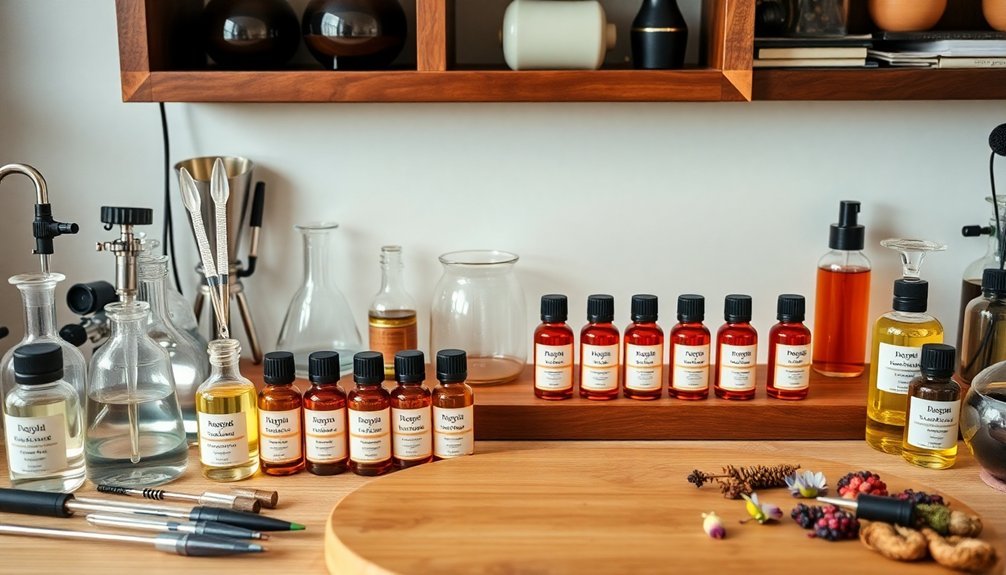
Creating natural perfumes requires a core set of essential tools for precise blending and testing.
You'll need glass beakers and stirring rods that can be thoroughly cleaned and reused, along with pipettes for transferring your liquid ingredients. A digital scale that measures to 0.01g guarantees accuracy in your formulations.
For testing your creations, you'll want perfume tester strips and fragrance blotters to evaluate scent profiles and longevity.
Don't forget droppers for precise application and lab-quality filter paper with funnels for clean transfers. A magnetic stirrer with magnet bars can make your blending process more efficient.
Keep measuring cups and spoons handy for consistent measurements.
Base Oils and Carriers for Perfume Making
Success in natural perfumery begins with selecting the right carrier oils as your foundation.
You'll want to choose oils that complement your fragrance while offering stability and skin compatibility.
- Pick jojoba oil when you need a stable, long-lasting base that mimics your skin's natural oils.
- Choose fractionated coconut oil for a lightweight, non-greasy texture that won't compete with your essential oils.
- Select sweet almond oil if you're working with sensitive skin, as it provides gentle nourishment and antioxidant protection.
- Opt for grapeseed oil when you need a neutral-scented carrier that absorbs quickly and won't interfere with your fragrance blend.
Remember that each carrier oil brings unique benefits, from avocado's rich moisturizing properties to rosehip's regenerative qualities.
Your choice will greatly impact your perfume's final character and performance.
Safety Equipment and Workspace Requirements
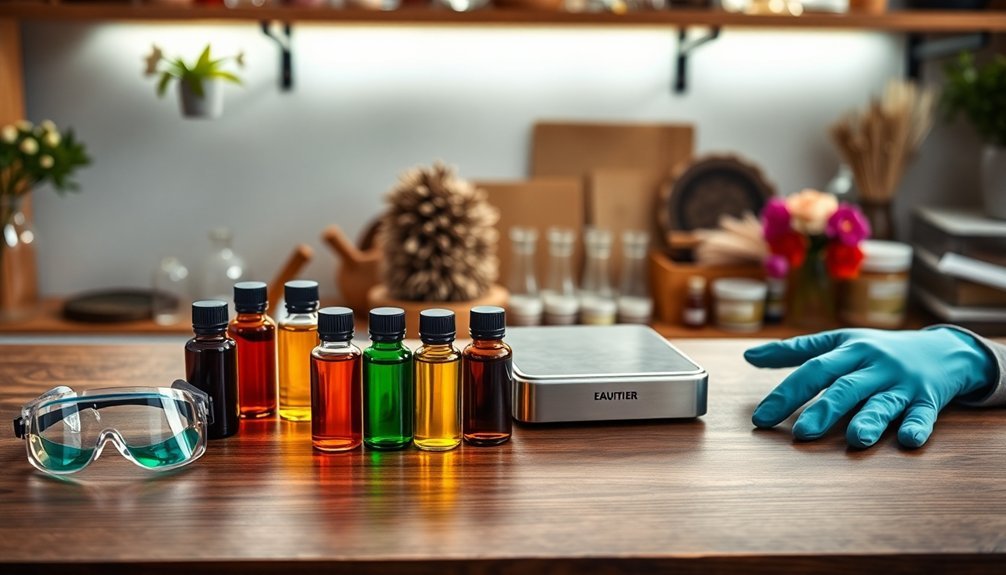
While natural perfume making can be enjoyable, your safety should always come first.
You'll need essential protective gear including a lab coat, safety goggles, nitrile gloves, and a mask rated for oil vapors. Don't forget a plastic apron for additional protection against spills.
Your workspace must be well-ventilated and equipped with emergency response tools.
Install a safety shower, eye wash station, and first aid kit within easy reach. If you're working in an area without constant water supply, set up a tank-fed shower system with heated water.
Keep your materials organized using stainless steel trays and perfumery racks.
Store your ingredients alphabetically and use proper carrying racks when transporting materials between stations.
Always secure hazardous substances separately to prevent accidental exposure.
Specialized Filtration and Straining Tools
Once your safety equipment is in place, proper filtration tools become the next cornerstone of natural perfume making.
You'll need specialized equipment to guarantee your fragrances are pure and free from unwanted particles.
At the heart of your filtration setup should be:
- A glass funnel paired with high-quality filter papers to strain your perfume concentrates
- Depth filter media for processing essential oils and oleoresins
- Activated carbon filters for color correction and particulate removal
- An enclosed filtration system to maintain fragrance integrity
For smaller batches, you can use unbleached coffee filters as a cost-effective alternative.
If you're working with essential oils and alcohols, consider adding micro-media filters to reduce haze.
Record-Keeping and Documentation Supplies
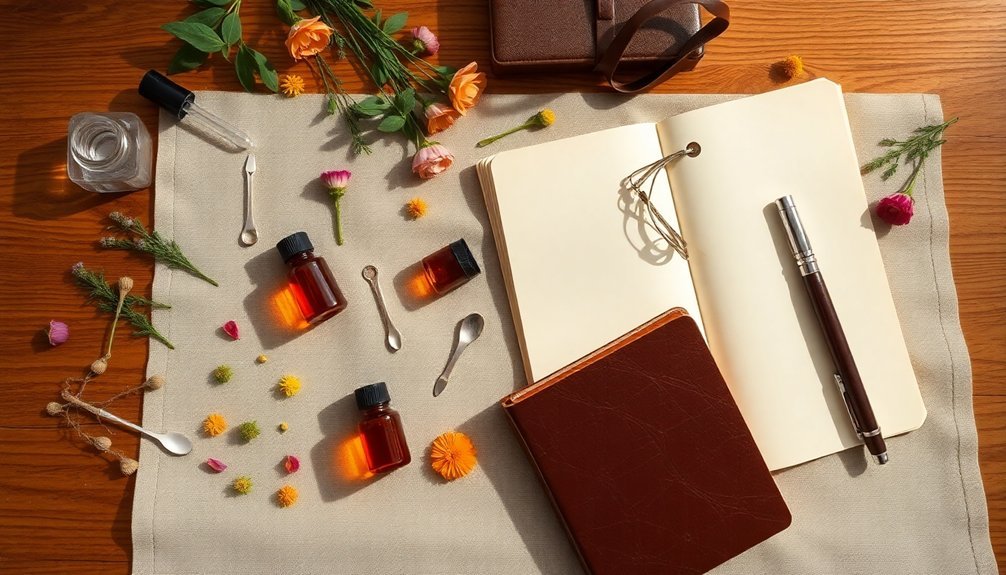
You'll find digital perfume recipe apps invaluable for organizing your formulas and tracking ingredient inventories on your smartphone or tablet.
A detailed lab notebook serves as your essential companion for recording experiments, observations, and modifications to your natural perfume creations.
Using blend documentation templates helps you maintain consistency in your record-keeping while ensuring you capture all vital details, from ingredient ratios to aging notes.
Digital Perfume Recipe Apps
When creating natural perfumes, digital recipe apps serve as indispensable tools for modern perfumers. Apps like Aroma-Tune, Superfumista, and Perfumer help you transform your fragrance ideas into precise formulations while maintaining detailed records of your work.
- Use Aroma-Tune's AI-driven system to input your ideas through voice or text, receiving instant feedback on costs, stability, and evaporation rates.
- Create mood boards and collaborate with professional perfumers through Superfumista's interactive platform.
- Document your essential oil recipes with Perfumer's intuitive interface, tracking ingredients by drops and color.
- Access real-time analytics and IFRA standards compliance data to guarantee your creations are safe and stable.
These digital tools enhance your creative process while maintaining professional-grade documentation of your perfume formulations.
Lab Notebook Essentials
Meticulous record-keeping forms the backbone of successful natural perfumery.
You'll need a dedicated lab notebook to document your perfume-making journey and guarantee you can replicate your successful creations. Start with a record book specifically for your fragrance experiments, along with reliable pens for taking clear, detailed notes.
Include formula sheets in your notebook to outline specific blend ratios and keep track of modifications.
You'll want to document dates, outcomes, and personal observations for each experiment. It's essential to maintain a perfume journal where you can record your creative process and track how different combinations develop over time.
Don't forget to leave space for additional notes about unexpected results or adjustments you make during the blending process.
Blend Documentation Templates
Proper documentation templates serve as the foundation for consistent and reliable perfume creation.
You'll need well-structured forms to track every aspect of your perfume-making journey, from initial experiments to final formulations.
Create these essential templates for your perfumery work:
- A blend worksheet with spaces for ingredient names, amounts used, IFRA restrictions, and dilution ratios
- An evaluation form featuring time intervals for recording how scents develop (top, heart, and base notes)
- A material inventory sheet to monitor your supplies, including purchase dates and quantities
- A revision tracker to document modifications, successes, and failures of each formula
Keep your templates organized in a dedicated perfume journal, and always include spaces for dates, batch numbers, and detailed observations.
Storage Solutions for Raw Materials

Successful natural perfume making depends heavily on how you store your raw materials.
You'll need airtight plastic containers or bags to protect your ingredients from air and moisture, while avoiding cardboard boxes that let vapors through.
Consider using stainless steel or borosilicate containers for extra durability.
Keep your storage area cool and dry, maintaining temperatures between 10°C to 21°C and humidity below 60%.
For sensitive materials, use refrigeration at 3°C to 7°C.
Organize your ingredients on tiered racks or multi-level systems for easy access and visibility, and label everything clearly.
Store frequently used materials at your workstation while keeping bulk supplies in a separate area.
Always protect materials from direct sunlight and artificial lighting, and keep them away from heat sources and high-humidity areas.
Aroma Testing and Evaluation Tools
When you're ready to evaluate your perfume creations, you'll need professional perfume testing strips to assess the scents properly.
You'll want to use clean, uncontaminated blotter papers that measure about 5 inches long, dipping them into your fragrances and allowing them to dry before testing.
Your evaluation setup should also include pipettes for precise oil transfers and glass beakers for mixing, ensuring accurate measurements and consistent results.
Perfume Testing Strip Basics
Testing strips serve as essential tools in natural perfumery, allowing you to evaluate fragrances with precision and clarity. Made from thick, odorless paper, these strips help you assess everything from individual oils to complex blends while preventing cross-contamination between scents.
To use testing strips effectively:
- Write the fragrance name at one end of the strip
- Apply 1-2 drops of your chosen scent to the opposite end
- Bend the strip to keep the scented portion away from surfaces
- Fan it gently in front of your nose at different intervals
You'll want to store your unused strips in their original packaging, keeping them away from any aromatic substances.
This protection guarantees you'll get accurate readings when you're evaluating fragrance notes, stability, and longevity.
Scent Evaluation Equipment Setup
Professional scent evaluation requires four key pieces of equipment: olfactometers, sampling devices, comparative measurement tools, and automated testing systems.
You'll find industry-standard olfactometers like the TO8 and TO9 evolution models that offer 4-station or 6-station setups for precise measurements.
For sampling, you'll need vacuum containers and devices like the CSD30, which runs for 30-minute intervals.
When working with concentrated scents, use the EPD pre-dilution system or GSP diluter. Don't forget quality-approved Nalophan or Kynar® PVDF sampling bags.
To compare scent intensities, you'll want the Acetone Comparative Scale and PureSniff systems for triangular testing.
For thorough analysis, consider Anton Paar's Flavor & Fragrance Measurement System, which measures density, refractive index, optical rotation, and color in one automated process.
Quality Control and Preservation Equipment
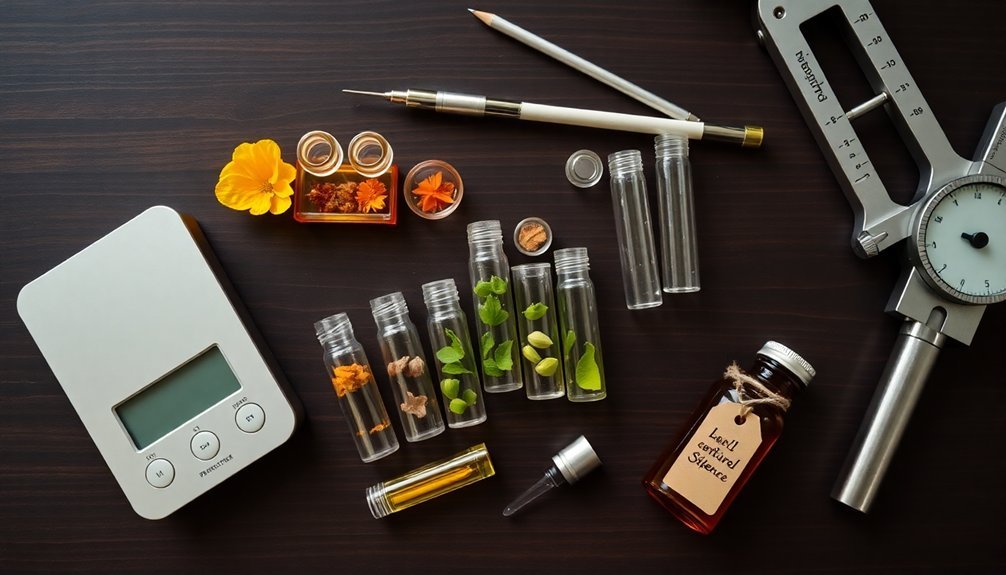
Creating natural perfumes requires specific equipment to maintain quality and extend shelf life.
You'll need tools for testing, monitoring, and preserving your fragrances to guarantee they meet professional standards and remain stable over time.
- Professional pH meters and thermometers to monitor stability during temperature trials
- Light-proof amber glass containers with airtight seals for storage testing
- Clean patch testing applicators and sterilized testing strips for safety evaluations
- Digital hygrometers to measure environmental humidity levels
Store your quality control equipment in a dedicated, clean workspace away from your perfume-making area to prevent cross-contamination.
Keep detailed logs of all test results using standardized forms to track changes over time.
When conducting stability tests, you'll want reliable instruments that can provide consistent, accurate measurements across multiple batches.
Frequently Asked Questions
How Long Does Homemade Perfume Typically Last Before the Scent Fades?
Your homemade perfume's scent will typically last 2-4 hours on your skin. You'll get longer wear if you've used fixatives, applied it to moisturized skin, and targeted pulse points for application.
Can I Sterilize and Reuse Glass Bottles From Store-Bought Perfumes?
Yes, you can safely reuse store-bought perfume bottles. Just clean them thoroughly with hot soapy water, then sterilize using any method like boiling, oven heating, or alcohol rinse before refilling with your new fragrance.
What's the Ideal Room Temperature for Storing Perfume-Making Supplies?
Keep your perfume-making supplies between 60-70°F (15-21°C). You'll want to maintain this stable temperature and avoid heat sources to prevent your fragrance oils from degrading or evaporating over time.
How Often Should Perfume-Making Tools Be Cleaned Between Different Blends?
You'll need to clean your tools thoroughly between each blend to prevent cross-contamination. Don't skip this step – even trace amounts of previous scents can alter your new creation's intended fragrance profile.
Are There Specific Tools Needed for Making Solid Perfumes Versus Liquid Ones?
Yes, you'll need different tools. For solid perfumes, use melting equipment like double boilers and molds. For liquid perfumes, you'll require alcohol-safe beakers, precise droppers, and amber glass bottles for storage.
In Summary
You'll need all these tools to create professional-quality natural perfumes at home. Make sure you've got the right equipment before starting – from precise measuring instruments to proper storage containers. Don't skip safety gear or documentation supplies, as they're essential for consistency and safety. With this complete toolkit, you're ready to explore the art of natural perfumery and create unique signature scents.

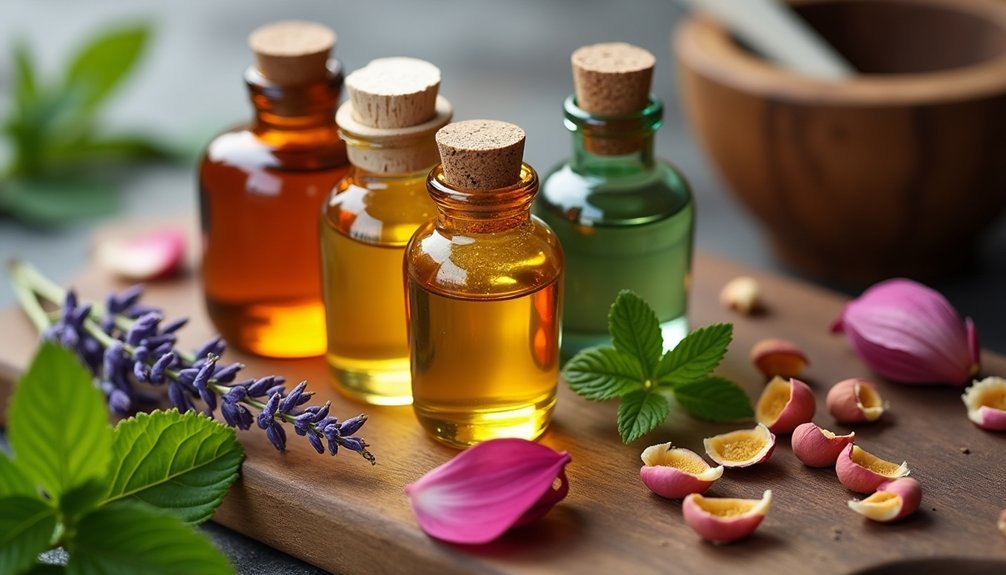



Leave a Reply